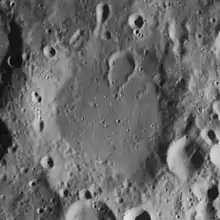Gauricus (crater)
Gauricus is a lunar impact crater that is located in the rugged southern part of the Moon's near side. It was named after Italian astronomer Luca Gaurico.[1] Nearly attached to the western rim is the heavily eroded crater Wurzelbauer, and to the north-northwest lies Pitatus.
 Lunar Orbiter 4 image | |
| Coordinates | 33.8°S 12.6°W |
|---|---|
| Diameter | 79 km |
| Depth | 2.7 km |
| Colongitude | 14° at sunrise |
| Eponym | Luca Gaurico |
The rim of this crater has become worn and eroded by subsequent impacts, resulting in a round-shouldered outer wall that is pock-marked by a number of lesser craters. The most notable of these are Gauricus B and Gauricus D along the southern rim and Gauricus G intrudes into the eastern rim. The worn satellite crater Gauricus A is attached to the exterior rim along the south-southwest.
In contrast, the interior floor is relatively level and featureless. Only the merged crater formation Gauricus F, lying along the northern rim, marks the floor. The bottom is covered by wisps of ray material from Tycho to the south.
Satellite craters
By convention these features are identified on lunar maps by placing the letter on the side of the crater midpoint that is closest to Gauricus.
| Gauricus | Latitude | Longitude | Diameter |
|---|---|---|---|
| A | 35.6° S | 13.4° W | 38 km |
| B | 35.3° S | 12.2° W | 23 km |
| C | 35.2° S | 10.7° W | 11 km |
| D | 35.1° S | 11.4° W | 13 km |
| E | 32.5° S | 11.8° W | 7 km |
| F | 33.0° S | 12.6° W | 12 km |
| G | 33.9° S | 11.0° W | 18 km |
| H | 38.1° S | 13.3° W | 8 km |
| J | 32.3° S | 11.9° W | 10 km |
| K | 33.3° S | 13.9° W | 5 km |
| L | 34.0° S | 13.8° W | 4 km |
| M | 34.4° S | 13.6° W | 6 km |
| N | 32.4° S | 12.7° W | 7 km |
| P | 35.1° S | 12.4° W | 6 km |
| R | 34.8° S | 13.3° W | 6 km |
| S | 33.9° S | 10.1° W | 15 km |
References
- "Gauricus (crater)". Gazetteer of Planetary Nomenclature. USGS Astrogeology Research Program.
- Andersson, L. E.; Whitaker, E. A. (1982). NASA Catalogue of Lunar Nomenclature. NASA RP-1097.CS1 maint: ref=harv (link)
- Bussey, B.; Spudis, P. (2004). The Clementine Atlas of the Moon. New York: Cambridge University Press. ISBN 978-0-521-81528-4.CS1 maint: ref=harv (link)
- Cocks, Elijah E.; Cocks, Josiah C. (1995). Who's Who on the Moon: A Biographical Dictionary of Lunar Nomenclature. Tudor Publishers. ISBN 978-0-936389-27-1.CS1 maint: ref=harv (link)
- McDowell, Jonathan (July 15, 2007). "Lunar Nomenclature". Jonathan's Space Report. Retrieved 2007-10-24.CS1 maint: ref=harv (link)
- Menzel, D. H.; Minnaert, M.; Levin, B.; Dollfus, A.; Bell, B. (1971). "Report on Lunar Nomenclature by the Working Group of Commission 17 of the IAU". Space Science Reviews. 12 (2): 136–186. Bibcode:1971SSRv...12..136M. doi:10.1007/BF00171763.CS1 maint: ref=harv (link)
- Moore, Patrick (2001). On the Moon. Sterling Publishing Co. ISBN 978-0-304-35469-6.CS1 maint: ref=harv (link)
- Price, Fred W. (1988). The Moon Observer's Handbook. Cambridge University Press. ISBN 978-0-521-33500-3.CS1 maint: ref=harv (link)
- Rükl, Antonín (1990). Atlas of the Moon. Kalmbach Books. ISBN 978-0-913135-17-4.CS1 maint: ref=harv (link)
- Webb, Rev. T. W. (1962). Celestial Objects for Common Telescopes (6th revised ed.). Dover. ISBN 978-0-486-20917-3.CS1 maint: ref=harv (link)
- Whitaker, Ewen A. (1999). Mapping and Naming the Moon. Cambridge University Press. ISBN 978-0-521-62248-6.CS1 maint: ref=harv (link)
- Wlasuk, Peter T. (2000). Observing the Moon. Springer. ISBN 978-1-85233-193-1.CS1 maint: ref=harv (link)
| Wikimedia Commons has media related to Gauricus (crater). |